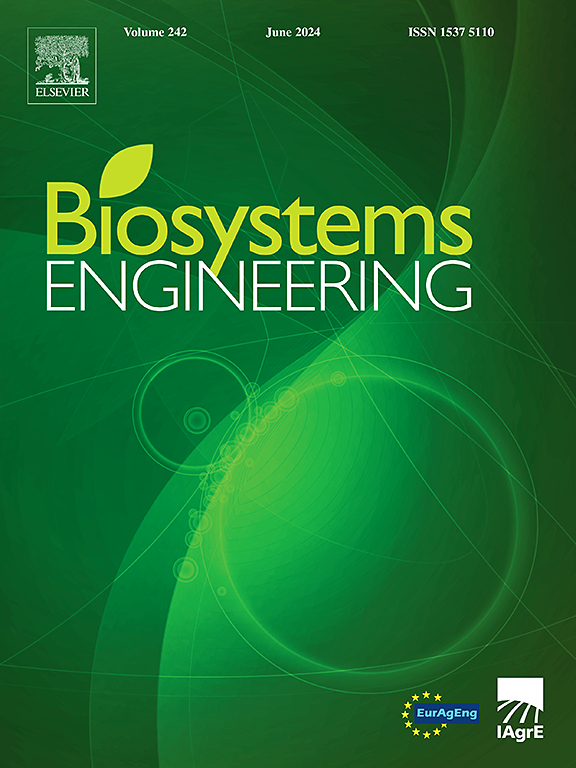3D plant segmentation: Comparing a 2D-to-3D segmentation method with state-of-the-art 3D segmentation algorithms
IF 5.3
1区 农林科学
Q1 AGRICULTURAL ENGINEERING
引用次数: 0
Abstract
Plant measurements are crucial to determine which plants grow optimal under certain conditions. These measurements can be done by hand, or automated using cameras, also known as image-based plant phenotyping. These images can be used to create point clouds to measure plant traits in 3D. To extract plant traits, accurate segmentation is crucial. Most point cloud segmentation methods rely on 3D segmentation algorithms. These algorithms are not as advanced and developed as 2D algorithms. In addition, 2D neural networks are pre-trained on large diverse datasets. In our work, it was therefore hypothesised that segmentation of point clouds using projection-based methods can obtain a higher accuracy than voxel or point-based algorithms. To test this hypothesis, a 2D-to-3D reprojection method was developed and compared with three state-of-the-art 3D segmentation algorithms; Swin3D-s, Point Transformer v3 and MinkUNet34C. The 2D-to-3D method segmented images using Mask2Former, reprojected the predictions to the point cloud, and used a majority vote algorithm to merge multiple predictions. All algorithms were trained and tested to segment 3D point clouds into leaves, main stem, side stem, and pole. There was no significant difference between the 2D-to-3D, Swin3D-s and Point Transformer v3 algorithm, indicating that state-of-the-art voxel or point-based methods perform similar than our projection-based method. However, the 2D-to-3D method had a higher performance by including virtual cameras and it had a higher training efficiency. With only five annotated plants, a similar performance was obtained than training Swin3D-s on 25 plants indicating the added value of the developed pipeline.
3D植物分割:比较2d到3D分割方法与最先进的3D分割算法
植物测量对于确定哪些植物在特定条件下生长最佳是至关重要的。这些测量可以手工完成,也可以使用相机自动完成,也称为基于图像的植物表型。这些图像可以用来创建点云,在3D中测量植物的特征。准确的分割是提取植物性状的关键。大多数点云分割方法依赖于三维分割算法。这些算法不像二维算法那样先进和发达。此外,二维神经网络在大量不同的数据集上进行预训练。因此,在我们的工作中,假设使用基于投影的方法对点云进行分割可以获得比基于体素或基于点的算法更高的精度。为了验证这一假设,开发了一种2d到3D的重投影方法,并与三种最先进的3D分割算法进行了比较;Swin3D-s,点变压器v3和MinkUNet34C。2D-to-3D方法使用Mask2Former对图像进行分割,将预测结果重新投影到点云,并使用多数投票算法合并多个预测结果。所有算法都经过训练和测试,将3D点云分割为叶片、主茎、侧茎和极。2D-to-3D、Swin3D-s和Point Transformer v3算法之间没有显著差异,这表明最先进的体素或基于点的方法与我们基于投影的方法相似。而2D-to-3D方法由于包含虚拟摄像机,具有更高的性能和训练效率。仅使用5种带注释的植物,就获得了与在25种植物上训练Swin3D-s相似的性能,这表明开发的管道具有附加价值。
本文章由计算机程序翻译,如有差异,请以英文原文为准。
求助全文
约1分钟内获得全文
求助全文
来源期刊

Biosystems Engineering
农林科学-农业工程
CiteScore
10.60
自引率
7.80%
发文量
239
审稿时长
53 days
期刊介绍:
Biosystems Engineering publishes research in engineering and the physical sciences that represent advances in understanding or modelling of the performance of biological systems for sustainable developments in land use and the environment, agriculture and amenity, bioproduction processes and the food chain. The subject matter of the journal reflects the wide range and interdisciplinary nature of research in engineering for biological systems.
 求助内容:
求助内容: 应助结果提醒方式:
应助结果提醒方式:


